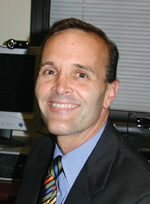
Kim Templeton, University of Kansas Hospital
She grew up working with her hands—as a musician, playing piano and banjo, and in crafts, building furniture and working with wood. So it wasn’t a big stretch, once she was into medicine, for Kim Templeton to choose orthopedics. “You’re using the same sort of thought processes when you’re trying to take out a portion of bone or do a reconstruc-tion, understanding what a 3-dimensional structure looks like,” she says.
Templeton is all about bone work: One of her e-mail usernames is “osteocyte.” Turns out that “osteoclast” was already taken, as was her next choice, “osteoblast.” “There must be a bunch of bone nerds out there,” she concedes.
A St. Louis native, Templeton earned her M.D. at Mizzou, following undergrad work in biology at Washington University in her hometown. She came to Kansas City after her residency in Chicago. She’s now a professor of orthopedic surgery at the University of Kansas School of Medicine and spends one day a week in rounds at the Veterans Affairs Medical Center.
Nationally recognized in her field, Templeton was the first surgeon in the U.S. to implant a titanium rod as replacement for cancerous bone in an adult patient—and immediately began to press for development of similar devices for use with children.
The challenges and rewards of her work are two distinctly different sides of the same coin: The darker side, which happens rarely, shows up with a patient whose malignancy yields to no treatment. “That’s challenging and frustrating,” she says. “They’re coming to you for help, they’ve probably seen other health-care professionals already, and I hate to be the last person to see them and have to tell them there isn’t anything I can do.”
But then … “when you have people with something that is really aggressive, and you find a way to put something back together and have them come back out the other side, if not as functional as before, close to it—and be tumor-free.” Those, she says, are days to cherish.
Much of her spare time goes to organizations that focus on preventive care, one of her passions. “There’s so much we end up treating from things that could be prevented—injuries, osteoporosis, arthritis—so going out and doing work in prevention really keeps me grounded,” she says.

Jeff Holzbeierlein, University of Kansas Hospital
It’s counter-intuitive, perhaps, but Jeff Holzbeierlein finds reassurance for his choice of a medical career in cases that are among the toughest a physician will encounter: “After a patient has passed away of their disease despite your best efforts,” he says, “a call from the family thanking you for all that you did for the patient is really validating. In the end, that is why all of us do this—to make a difference in our patients’ and families’ lives.”
An Oklahoma native who returned to the Midwest after a career swing through New York, Holzbeierlein is an associate professor and director of urologic oncology for the University of Kansas Hospital. He also makes rounds at the Veterans Affairs Medical Center. Midwestern values, he says, plus family connections for himself and his wife in their hometown of Oklahoma City, brought him back. As did Brant Thrasher, the head of his department, who recruited him and exerted a powerful mentoring influence: “He has taught me a great deal about leadership, time management, and personal responsibility,” Holzbeierlein said.
Why urology? “Most urology patients are pretty happy patients and very pleasant,” Holzbeierlein said. And, while he might get an argument from most any obstetrician, he adds: “They always say that the urologists are the happiest docs in the hospital, and I have found that to be true.”
Urology, he said, blends both the surgical and diagnostic aspects of medicine. Among his specialties is bladder cancer, a disease that “continues to represent a great challenge to me as well as to all urologists,” he said. “It is a very humbling disease, meaning that it is often very aggressive and despite our best efforts all too often we are unable to cure our patients.”
Because of that, he finds his greatest reward in treating patients “who I know would otherwise die of their disease but because of our efforts they are allowed to live longer lives.” His teaching capacity projects his own skills onto the next generation, and he’s been recognized by the hospital for his work in mentoring residents.
An avid runner—he tries to run at least one marathon a year—he also is an active father of four who finds room on the scale of work/life balance to serve within the community of urologic specialists, with roles in various associations.